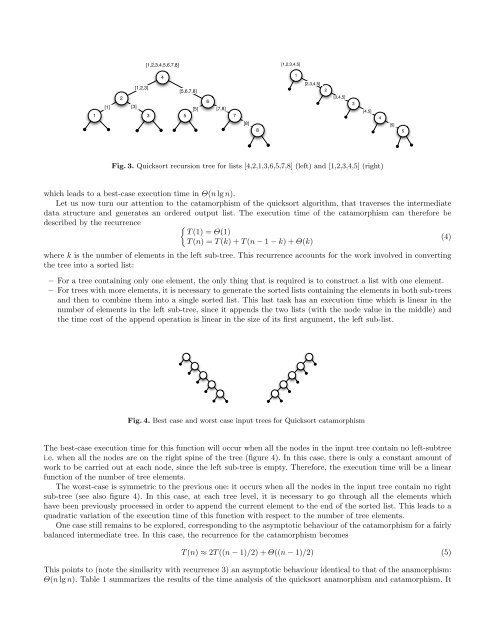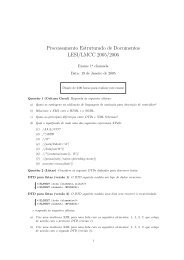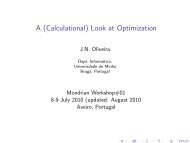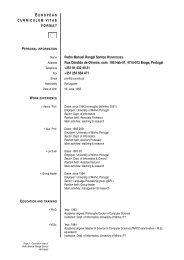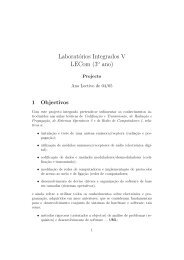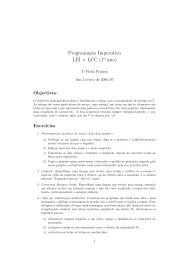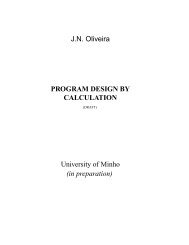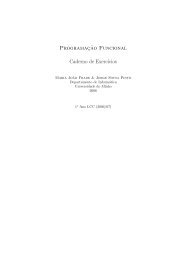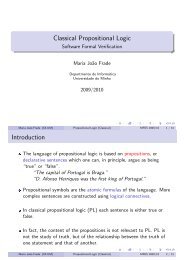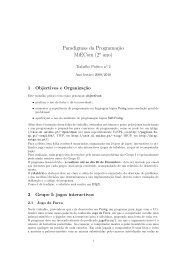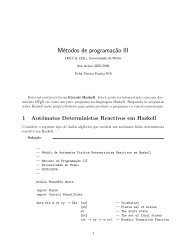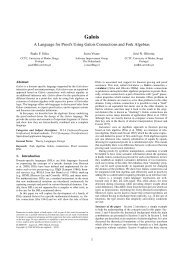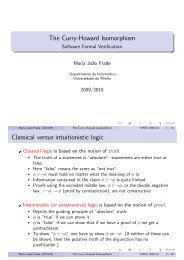Recursion Patterns and Time-analysis - Departamento de ...
Recursion Patterns and Time-analysis - Departamento de ...
Recursion Patterns and Time-analysis - Departamento de ...
Create successful ePaper yourself
Turn your PDF publications into a flip-book with our unique Google optimized e-Paper software.
[1,2,3,4,5,6,7,8][1,2,3,4,5][1,2,3]2[1] [3]1 34[5,6,7,8]5[5]6[7,8]7[8]81[2,3,4,5]2[3,4,5]3[4,5]4[5]5Fig. 3. Quicksort recursion tree for lists [4,2,1,3,6,5,7,8] (left) <strong>and</strong> [1,2,3,4,5] (right)which leads to a best-case execution time in Θ(n lg n).Let us now turn our attention to the catamorphism of the quicksort algorithm, that traverses the intermediatedata structure <strong>and</strong> generates an or<strong>de</strong>red output list. The execution time of the catamorphism can therefore be<strong>de</strong>scribed by the recurrence {T (1) = Θ(1)(4)T (n) = T (k) + T (n − 1 − k) + Θ(k)where k is the number of elements in the left sub-tree. This recurrence accounts for the work involved in convertingthe tree into a sorted list:– For a tree containing only one element, the only thing that is required is to construct a list with one element.– For trees with more elements, it is necessary to generate the sorted lists containing the elements in both sub-trees<strong>and</strong> then to combine them into a single sorted list. This last task has an execution time which is linear in thenumber of elements in the left sub-tree, since it appends the two lists (with the no<strong>de</strong> value in the middle) <strong>and</strong>the time cost of the append operation is linear in the size of its first argument, the left sub-list.Fig. 4. Best case <strong>and</strong> worst case input trees for Quicksort catamorphismThe best-case execution time for this function will occur when all the no<strong>de</strong>s in the input tree contain no left-subtreei.e. when all the no<strong>de</strong>s are on the right spine of the tree (figure 4). In this case, there is only a constant amount ofwork to be carried out at each no<strong>de</strong>, since the left sub-tree is empty. Therefore, the execution time will be a linearfunction of the number of tree elements.The worst-case is symmetric to the previous one: it occurs when all the no<strong>de</strong>s in the input tree contain no rightsub-tree (see also figure 4). In this case, at each tree level, it is necessary to go through all the elements whichhave been previously processed in or<strong>de</strong>r to append the current element to the end of the sorted list. This leads to aquadratic variation of the execution time of this function with respect to the number of tree elements.One case still remains to be explored, corresponding to the asymptotic behaviour of the catamorphism for a fairlybalanced intermediate tree. In this case, the recurrence for the catamorphism becomesT (n) ≈ 2T ((n − 1)/2) + Θ((n − 1)/2) (5)This points to (note the similarity with recurrence 3) an asymptotic behaviour i<strong>de</strong>ntical to that of the anamorphism:Θ(n lg n). Table 1 summarizes the results of the time <strong>analysis</strong> of the quicksort anamorphism <strong>and</strong> catamorphism. It


